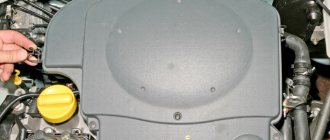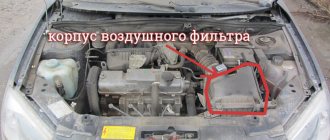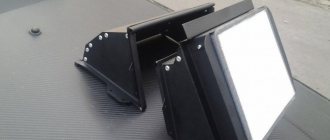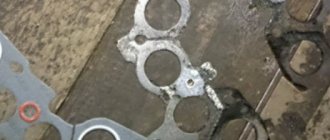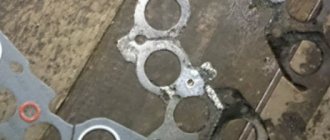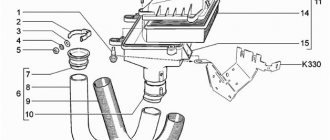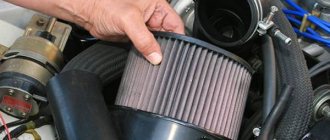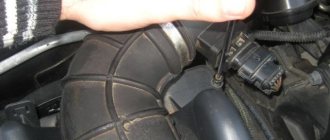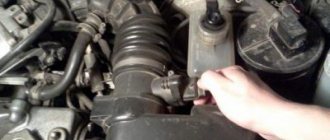The air filter is an important consumable component that protects key engine components from dirt, dust, stones, insects and other debris that can harm the stable operation of the engine. The air filter should be changed every 10-15 thousand kilometers, or in accordance with the manufacturer's recommendations.
When replacing, the driver may encounter the problem that traces of engine oil appear on the filter element. In some situations, the driver pays attention to this due to symptoms of improper operation of the air filter, which has not yet completed its required mileage. It is prohibited to operate a filter that contains traces of engine oil for reasons of safety of the car engine. At the same time, installing a new filter element will not get rid of the problem, since after a few kilometers of run oil traces will appear on it. Before changing an air filter that has traces of oil on it, you should find the problem and fix it.
Reasons for the appearance and methods of eliminating the appearance of oil in the air filter and corrugation of VAZ cars
When operating VAZ-2110, 2114, 2115, owners are faced with the problem of engine oil appearing in the air filter and corrugation. This happens in 8-valve and 16-valve engines. As a result, the air filter clogs prematurely and loses the required capacity, and this leads to a change in the parameters of the fuel-air mixture. The car's power decreases, and the engine wears out more intensely. Often the appearance of oil in the air filter and bellows leads to failure of the mass air flow sensor, which will require its replacement.
Cooling system pipes for VAZ 2110, 2111, 2112 (video)
Cooling system hoses for VAZ 2110, 2111, 2112...
Hello dear readers of the RtiIvaz.ru blog. Today I want to continue the conversation about the auto radiator pipes of the cooling system of the VAZ Lada 2110 “ten”, Lada 2111 “eleventh” and 2112 Lada “twelfth”.
In the previous auto article, we looked at the radiator hoses of the cooling system of the VAZ 2108, 2109, 21099, 2113, 2114, 2115. We looked at the video and photos and found out what the sets of pipes of the “eight”, “nine”, “ninety-nine”, “thirteenth” are , the “fourteenth” and “fifteenth” Lada models differ from each other.
We determined the “upper” supply and also found out which “lower” coolant outlet was a thick rubber hose. You have found out where which rubber tubes fit, today we will continue to look at the video of the Lada 2110, 2111, 2112 pipes.
The cooling system pipes are such a thing that they always seem to be in good condition, but they make themselves felt when you don’t expect them...
You've probably seen cars on the road more than once with their hoods open in a cloud of steam.
So the coolant floats, falling on the burning engine parts (exhaust manifold), escaping in a fountain through a burst rubber pipe.
Therefore, guys, be vigilant if you haven’t changed rubber hoses for a long time. Don’t tempt fate—guessing whether you’ll be lucky or not will be unlucky—but replace all the rubber hoses of your car in advance.
What kind of outlet and inlet rubber hoses of the VAZ 2110, 2111, 2112 radiator are they, look at the video and photo, friends...
Look at the photo on the left, numbered -1, the rubber tube supplying coolant is the “upper” one, and numbered -2, the rubber tube is taking out the “lower” coolant. Numbered -3; -4 “shorts”, one of which is a bypass from the block head to the water pump, and the other “short” is a connecting coupling.
The considered pipes on the left are suitable for VAZ cars of the “tenth” family with carburetor and injection engines.
- 2110-1303025 radiator supply hose, number -1 (see photo)
- 2110-1303010 radiator outlet hose, number -2 (see photo)
- 2108 -1303092Р coupling connecting the thermostat and water pump, as well as the bypass “short”, numbers -3; -4 (see photo)
Next, look at the photo on the right under number -5 for the coolant supply pipe on the “top”, and at number -6 for the outlet pipe. cool liquid "bottom". You see number -7, the so-called “long corner” bypass pipe. cool liquids.
These pipes on the right are for Lada VAZ-2111 and Lada VAZ-2112 cars with an injection engine. There are also the longest “upper inlet” and “lower outlet” pipes on the VAZ-2112 with a 16-valve engine.
- 2112-1303025 radiator supply hose, number -5 (see photo)
- 2112-1303010 radiator outlet hose, number -6 (see photo)
- 2108 -1303092Р coupling connecting thermostat and water pump “shorty”, number -8 (see photo)
- 2109-1303093-01 connecting hose for thermostat and water pump bypass “long angle”, number -7 (see photo)
Next, friends, watch the video:
Dear car enthusiasts, did you like my previous publication? How do you feel about this? Should I continue the topic of rubber pipes for the cooling system of VAZ cars?
Reasons for the appearance of oil in the air supply system
To make sure that the engine is throwing oil into the air filter of the VAZ-2110, 2114, 2115, it is enough to disconnect the corrugation, in which you can see oil splashes and drips. Sometimes when replacing a filter you can see that it is not just dirty, but saturated with machine oil. To identify the cause of oil getting into the air filter, you need to completely remove the pipe so that it does not interfere with operation, for which you need to loosen the clamp and disconnect it from the throttle valve.
This will open a tube above the throttle valve with a hose connecting it to the valve cover, where excess oil is supplied. You need to remove the rubber tube from the valve cover and try to blow it out. If the throttle tube is not blown through, it means the system is clogged, and this is the reason for the appearance of oil in the corrugation and air filter. This situation is due to the fact that the oil does not return to the cylinder block through a rubber hose, but is discharged under pressure into the air supply system, first of all into the corrugation, and then to the air filter.
Much less often, squeezing oil into the air filter bellows indicates severe wear of the piston group, in which case a major engine overhaul will be required, but more often the problem lies in the obstruction of the throttle valve tube described above. It happens that the rings on the pistons have already come together in a row, they leak oil, and the engine requires serious repairs, while no traces of engine oil are observed on the air filter and in the bellows, they are absolutely clean.
The role of pipes in the VAZ stove
The heating system in the car operates automatically, thanks to which the air enters the cabin at the required temperature with an error of about 2 degrees. To connect various elements to each other, where the working fluid is present, pipes are used. Experts recommend that VAZ 2110-2112 owners pay special attention to the pipes and monitor their condition.
Defects that are not corrected in time may subsequently affect the operation of the car engine. It is also important to monitor the condition of the clamps that are responsible for the tightness.
- The lower pipe serves as a supply of coolant to the radiator. Hot coolant flows here.
- The upper pipe plays a draining role; the cooled liquid leaves the heater radiator.
- Short couplings are required for the pump and thermostat.
If faulty pipes or coolant leaks are detected on a VAZ 2110-2112, professionals recommend immediately replacing the faulty elements.
How to prevent oil from getting into the air filter
The simplest solution is to simply break through the clogged tube using soft wire with a diameter of 0.8 mm. But since the entrance to this tube is angled, you need to act very carefully, in addition, this does not always lead to successful cleaning of the tube. When the connector is cleaned with wire, you need to try to blow out the tube again; if air flow is restored, oil will no longer get into the air line.
You need to blow through the throttle tube through a rubber hose; this can be done with your mouth, using a special syringe or a hand pump, which will help create sufficient pressure. When the pipe is cleaned, air passes freely, and oil will not enter the engine air supply system, being discharged into the cylinder block; the bellows and filter will remain dry and operate normally.
Cleaning the throttle body
If it was not possible to pierce the tube with wire, you need to completely dismantle the throttle valve. This is done as follows:
- the pipes approaching the damper from above are removed;
- the latch is removed and the cable controlling the gas is removed;
- the electronic throttle position sensor is disconnected;
- unscrew 2 13 nuts securing the damper (one higher, the other lower).
The throttle valve is easily removed from the engine block, after which it needs to be cleaned. This does not require additional equipment and tools; all work can be done in a regular garage.
To clean the throttle valve, we take the same wire with a diameter of 0.8 mm and clean the tube from the reverse side. We periodically use a cleaning aerosol that will help wash away any remaining carbon deposits and other debris from the pipe. You can use a liquid lubricant like WD-40, which also removes carbon deposits and other contaminants well. After this, the pipe is purged again, and if air passes through it, the throttle valve is replaced and engine oil will no longer appear in the air filter.
When assembling the air filter, you need to thoroughly clean the corrugation so that there are no oil stains left on it. If the filter itself becomes dirty, it is better to replace it, otherwise the air supply to the engine will be difficult, which will negatively affect its operation. After this, the car can be operated normally.
To check the effectiveness of the repair, after a month it is advisable to remove the air filter bellows and carefully inspect it. There should be no oil drips or splashes in its opening. If they appear, you need to clean the throttle tube again using one of the proposed methods. But recurrence of the problem after a month of operation is rare.
Where to do the work
You can do the work yourself. This can be done in the garage or at +t0 outside. Just watch the video and purchase the original corrugation recommended for use by the manufacturer.
If other complex measures are being carried out, it is better to entrust the replacement to the service station masters. They perform work in accordance with established standards using modern equipment. And they will install the original corrugation. At least they have all the conditions for this. And also, the service station technicians provide a guarantee for the installation.
Reasons for the appearance and methods of eliminating the appearance of oil in the air filter and corrugation of VAZ cars
When operating VAZ-2110, 2114, 2115, owners are faced with the problem of engine oil appearing in the air filter and corrugation. This happens in 8-valve and 16-valve engines. As a result, the air filter clogs prematurely and loses the required capacity, and this leads to a change in the parameters of the fuel-air mixture. The car's power decreases, and the engine wears out more intensely. Often the appearance of oil in the air filter and bellows leads to failure of the mass air flow sensor, which will require its replacement.
Reasons for the appearance of oil in the air supply system
To make sure that the engine is throwing oil into the air filter of the VAZ-2110, 2114, 2115, it is enough to disconnect the corrugation, in which you can see oil splashes and drips. Sometimes when replacing a filter you can see that it is not just dirty, but saturated with machine oil. To identify the cause of oil getting into the air filter, you need to completely remove the pipe so that it does not interfere with operation, for which you need to loosen the clamp and disconnect it from the throttle valve.
This will open a tube above the throttle valve with a hose connecting it to the valve cover, where excess oil is supplied. You need to remove the rubber tube from the valve cover and try to blow it out. If the throttle tube is not blown through, it means the system is clogged, and this is the reason for the appearance of oil in the corrugation and air filter. This situation is due to the fact that the oil does not return to the cylinder block through a rubber hose, but is discharged under pressure into the air supply system, first of all into the corrugation, and then to the air filter.
Much less often, squeezing oil into the air filter bellows indicates severe wear of the piston group, in which case a major engine overhaul will be required, but more often the problem lies in the obstruction of the throttle valve tube described above. It happens that the rings on the pistons have already come together in a row, they leak oil, and the engine requires serious repairs, while no traces of engine oil are observed on the air filter and in the bellows, they are absolutely clean.
Briefly about the prevention of ICE
In conclusion, we will consider some aspects of preventive measures designed to prevent the moment when the car’s air filter fills with oil due to defects in the cylinder-piston group. Their essence lies in the following points:
- Change the lubricant more often; if the manufacturer recommends, for example, changing it after 15,000 km, then you do not need to maintain this particular interval - it is better to change it after 10,000 km. The fact is that the timing depends on many parameters, including seasonality, operating conditions, and the quality of fuels and lubricants.
- Purchase only certified lubricants.
- Be sure to combine an oil change with the installation of new air and oil filters.
- Use only high-quality fuel from proven brands.
These simple rules will improve the performance of the motor and also increase its service life. It would not be superfluous to install a universal oil catcher on the crankcase gas supply tube. Its price is low, but the effect of its use will not be long in coming - the filter element will be reliably protected from lubricant penetration.
The air filter is an important consumable component that protects key engine components from dirt, dust, stones, insects and other debris that can harm the stable operation of the engine. The air filter should be changed every 10-15 thousand kilometers, or in accordance with the manufacturer's recommendations.
When replacing, the driver may encounter the problem that traces of engine oil appear on the filter element. In some situations, the driver pays attention to this due to symptoms of improper operation of the air filter, which has not yet completed its required mileage. It is prohibited to operate a filter that contains traces of engine oil for reasons of safety of the car engine. At the same time, installing a new filter element will not get rid of the problem, since after a few kilometers of run oil traces will appear on it. Before changing an air filter that has traces of oil on it, you should find the problem and fix it.
How to prevent oil from getting into the air filter
The simplest solution is to simply break through the clogged tube using soft wire with a diameter of 0.8 mm. But since the entrance to this tube is angled, you need to act very carefully, in addition, this does not always lead to successful cleaning of the tube. When the connector is cleaned with wire, you need to try to blow out the tube again; if air flow is restored, oil will no longer get into the air line.
You need to blow through the throttle tube through a rubber hose; this can be done with your mouth, using a special syringe or a hand pump, which will help create sufficient pressure. When the pipe is cleaned, air passes freely, and oil will not enter the engine air supply system, being discharged into the cylinder block; the bellows and filter will remain dry and operate normally.
VAZ 2110 Air filter and sound-absorbing pipe
The air intake by the engine contains dust and dirt particles that should not enter the combustion chambers, as they act as an abrasive on the cylinder walls and cause premature wear of the pistons and cylinder working surfaces. The air filter filter element cleans the air entering the engine cylinders and is located in the air filter housing (sound-absorbing pipe). The sound-absorbing pipe performs a very important task: it calms the uncontrolled rotating flow of fresh air and at the same time suppresses the noise generated by the air intake. In the Fiesta, the sound-absorbing pipe consists of a plastic housing and a fine-pored, accordion-shaped air filter element.
Air Filter Maintenance
The sucked air passes through the air filter housing, inside of which the filter element is secured with two plastic gaskets. The entire air flow passes through the filter, while dust and all dirt particles that accelerate engine wear are retained by the filter element. Larger foreign particles, such as insects or grains of sand, remain in the air filter housing. The air filter and filter element only function properly if they are constantly checked and maintained in good condition. A dirty filter element does not clean the intake air, which leads to a deterioration of the air-fuel mixture, increased toxicity of exhaust gases, and a decrease in engine power with increased fuel consumption.
Cleaning the air filter element
The filter element and oil catcher in those engine versions where it is installed must be cleaned at least once a year and changed once every two years
You need to purchase filter elements in specialized stores, and they do not necessarily have to be only original, but in any case, pay attention to the quality
Rice. 7.1. Location of the air hose clamps on the suction pipe and air flow meter
2. Unscrew the air filter cover, lift it and remove the filter element.
Rice. 7.2. Location of the oil catcher (1) in the air filter housing
Cleaning the filter element
1. Tap the filter element on a hard surface to loosen coarse dirt particles.
Rice. 7.3. Using compressed air to remove dust from a paper filter element
– direct the air stream only from bottom to top of the filter element. Otherwise, you will press dust into the filter pores;
Replacing the pipe: how it happens
When undergoing scheduled or unscheduled maintenance, a malfunction is detected, the corrugation should be replaced. This work is not difficult or difficult.
- Repair begins with unscrewing the retaining clamps or mounting bolts.
- Remove the unusable pipe.
- Replace with a new element and tighten the clamps or fastening nuts tightly to avoid further air suction.
To replace, you need to use the original corrugation. Follow the manufacturer's recommendations in this matter. For this purpose, there is an article listed in the catalog of original spare parts for modern cars.
What is it for? The original spare part will fit into place without any problems. Using a supplier's part or purchased corrugation on the market, get ready for installation problems.
When ordering a product from an online store, ask the manager about the quality of the corrugation. Agree with him to purchase goods from a normal manufacturer, and not a packaging company.
This service will cost 10-15 percent more than the samples put up for sale. But, in this way, you can bypass the problems with installing a low-quality element.
Having installed corrugations of dubious origin, it can be assumed that in the near future problems will arise in the operation of the power unit.
For your information. When cleaning the pipes from the air filter to the turbine and from the turbo/compressor to the intake manifold, attention should be paid to removing sand and dirt.
Air pipe
The air pipe is connected to the air cleaner. The float chamber cover contains a needle valve 11, a float 12, a balancing tube 4, an accelerator pump nozzle 5, and a number of connecting channels.
Air pipe - air pipe 7 is used to suck air into the impeller.
From the air pipe, air is directed into the diffuser, where its speed increases significantly and the pressure decreases. To reduce losses during air flow, a diffuser is used with angles at the inlet of 30 and at the outlet of 7 and with a smooth transition of the profile. In practice, the profile of diffusers, especially for carburetors with a single diffuser, differs from the optimal one due to the need to reduce the height of the carburetor. When departing from the most favorable ratio of the dimensions of the diffuser, the jet of moving flow is compressed, which, in turn, leads to a displacement of the zone of greatest rarefaction along the air movement. The movement of the air flow in the carburetor diffuser in a wide range of modes is turbulent. Turbulent air movement with intense turbulence is necessary for better crushing of the fuel flowing from the atomizer at significant speed.
| Diaphragm type automobile fuel pump diagram. |
The air intake flap and throttle valve are controlled from the driver's cab.
The design of the air pipe prevents the siphon release of the sludge evaporator contents into the sewer.
The float chamber, air pipe with air damper and acceleration pump are common to both mixing chambers.
When the engine is not running, the carburetor air pipe is closed with a cover 35 sealed with a felt gasket.
The dimensions of the flow sections of liquid and air pipes are calculated based on the condition of continuity of flows. In this case, the permissible speed of liquid flow through the pipe is assumed to be no more than 16 m/sec, air flow – no more than 75 m/sec.
An air pipe with an air damper and a separate float chamber cover are installed on top of the body.
| Diagram of a mixing gas burner type design.| Medium pressure injection burner with an annular combustion stabilizer designed by Lengiproinzhproekt. |
Air enters from the air duct into the air pipe 4, washes the central pipe 1 from the outside and exits the air chamber 5 between the twelve blades 6, where it acquires a vortex rotational motion.
| Schematic diagram of a basic carburetor. |
From the atmosphere, air passes through the air purifier and the air pipe through the minimum cross-section of the diffuser, where its speed increases significantly and the pressure decreases.
Cooling system diagram
All the main elements are described below.
1 – heater radiator; 2 – steam removal hose of the heater radiator; 3 – outlet hose; 4 – supply hose; 5 – coolant temperature sensor (in the block head); 6 – pump supply pipe hose; 7 – thermostat; 8 – filling hose; 9 – expansion tank plug; 10 – coolant level indicator sensor; 11 – expansion tank; 12 – exhaust pipe; 13 – liquid chamber of the carburetor starting device; 14 – radiator outlet hose; 15 – radiator supply hose; 16 – radiator steam outlet hose; 17 – left radiator tank; 18 – sensor for turning on the electric fan; 19 – fan electric motor; 20 – electric fan impeller; 21 – right radiator tank; 22 – drain plug; 23 – electric fan casing; 24 – timing belt; 25 – coolant pump impeller; 26 – supply pipe of the coolant pump; 27 – coolant supply hose to the throttle pipe; 28 – coolant drain hose from the throttle pipe; 29 – coolant temperature sensor in the outlet pipe; 30 – radiator tubes; 31 – radiator core.
Cooling system components
Now that you know the entire diagram of the VAZ-2112 cooling system, you should learn about all its main details in more detail:
Cooling radiator
Copper cooling radiator
The radiator is designed to cool the fluid in the system as it passes through it in the so-called “great circle” . It is made of aluminum, has a tubular-plate, two-pass design, and is equipped with plastic tanks, one of which has a special partition designed to allow coolant to pass through. The liquid to pass through the “large circle” flows through the upper pipe and exits through the lower one.
Expansion tank
This tank is quite reliable, but its connections sometimes have to be checked for leaks.
The expansion tank, made of translucent polyethylene, is designed to fill and control coolant. When the fluid in the system is completely filled, it should be in the tank between o and “MAX”. Two pipes for removing steam are built into the tank, one from the heater radiator, the other from the cooling radiator.
Expansion tank cap
Two types of expansion tank caps.
The tightness of the cooling system is ensured by the expansion tank cap, or rather by its inlet and outlet valves. The exhaust valve maintains increased pressure on a hot engine compared to atmospheric pressure, due to which the boiling point becomes higher, reducing the loss of steam.
Thermostat
The thermostat is designed to distribute coolant flows, controlling its temperature. On a cold engine, the coolant circulates only in a small circle, passing through the heater radiator and the throttle assembly heating unit. When the temperature rises to 87°C, the thermostat valve begins to open, and reaches full open at 102°C, releasing fluid in a “big circle”. The thermostat for the VAZ-2112 has an improved resistance of the throttle opening, due to which the fluid flow increases.
Why do you need a cold intake and how to implement it
We noticed that in hot weather, in a traffic jam or at traffic lights, the car accelerates worse, and after a while the throttle response returns. This is due to the fact that if the engine temperature is higher than the opening temperature of the thermostat, but lower than the temperature when the fan is turned on, then the system to prevent detonation delays the ignition to the late side. After you start driving, the air flow cools the radiator to the opening temperature of the thermostat, and the dynamics return. The system, realizing that the temperature has dropped, returns the OZ to its previous value.
There are several ways to make a cold air intake for the engine:
- Using aluminum corrugation
- Using plastic pipes
Cold intake made of aluminum corrugation
As a result, the new highway will have a snail shape. This design has been tested for years, and we can say that it is not inferior in reliability to the standard one.
